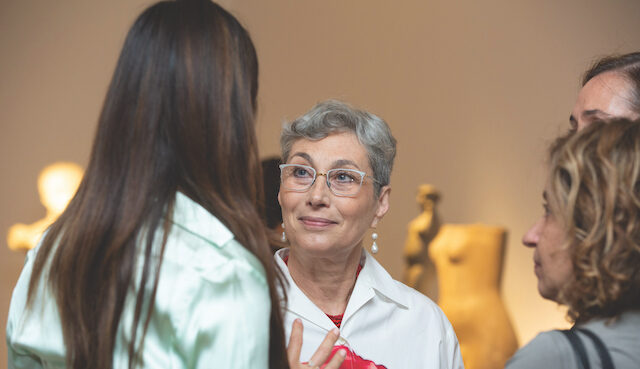Through her Lower Manhattan gallery, Laura Mattioli preserves and promotes the work of important 20th-century Italian creatives.
In the eyes of even the most adoring beholder, a stereotype exists that Italian visual art begins with a bang in antiquity, hits its peak in the Renaissance and ceases to be much of a factor by the mid-20th century. After all, the 1950s and ’60s were the era of Jackson Pollock, Andy Warhol and Roy Lichtenstein, right?
One woman has reformed that view by taking a lead role in celebrating Italy’s influence in the modern and postmodern movements. The daughter of a prominent art collector, Laura Mattioli is the founder of New York’s Center for Italian Modern Art. This is no place for pretty wall hangings. Since opening in 2013, CIMA has dedicated itself to the appreciation and study of Italian creatives who arguably belong among the pantheon of modern art greats.
Mattioli opens the doors of CIMA’s SoHo loft every weekend to those who want to get a close-up glimpse of important works and learn about the artists behind them.
Through November 13, the spotlight shines on “Italy’s Andy Warhol,” Mario Schifano, whose circle of friends and supporters included Jean-Luc Godard, Mick Jagger, and Keith Richards. The exhibition is curated by Francesco Guzzetti, Ph.D., the 2019–20 postdoctoral fellow at the Morgan Library and Museum’s Drawing Institute and former CIMA fellow (2014–15). Schifano’s work could often be quite puckish. His 1963 enamel on paper “Leonardo” mimics the sketch style of Leonardo da Vinci as though the master himself had rendered a self-portrait, with piercing eyes as mysterious as the Mona Lisa’s.
Mattioli spoke with Lou&A about the Schifano exhibit, her family’s art-world connections and her ongoing mission.
Lou&A: Tell us about your Italian background and your family’s connections to art.
Laura Mattioli: I was born in Italy in 1950, and both my parents are Italian. My father, Gianna Mattioli, was an important collector of Italian avant-garde and modern art from the first half of the 20th century. I was living all the time with artwork and met so many artists who were famous. My education was in art history, and I taught in Italy at the [Florence] Academy of Art. I began to organize the collection of my father in 1984. I later made friends with some artists in New York and became a collector myself.
Lou&A: What influenced you to create CIMA?
Mattioli: I formed the organization because I realized that Italian art of the 20th century was not as well known. The Italian artists were always seen as followers of the French. But that’s not necessarily true, because Italy always had a strong tradition of independence from any country. Their modern and contemporary art has always been different.
Lou&A: The CIMA experience definitely does not resemble what one might encounter in a traditional art museum. What was the thinking behind that?
Mattioli: I wanted to set it up like a house — a house where the paintings welcome you, the artists welcome you, and to give you the experience of a collector. Many times in a museum, people feel a bit embarrassed by the importance of the piece and the huge rooms. So to give them the sense of a house — where they can see up close, they can look, they can discuss — is a more intimate approach that I think can be very rich.
Lou&A: With the current CIMA exhibit, you’ve picked quite a character, the postmodern painter, collagist and filmmaker Mario Schifano. Tell us about the exhibit and its connection to New York City.
Mattioli: It takes into consideration just five years of his career, 1960-65. That’s when he was working more in relation with American art. Schifano was deeply involved in the surge that went on in New York. He came in 1963 and spent about 10 months here — not just with visual artists but also musicians, poets and those involved in the revolution of the moment. There was a deep exchange, and it’s interesting to see how everybody was going in the same direction, making something new for the world.
Lou&A: He also sounds like a larger-than-life pop culture figure somehow lost to 1960s history.
Mattioli: He drove around Rome in a Rolls Royce and had countless girlfriends. One of them was the model-actress Anita Pallenberg, who was later the lover of both Brian Jones and Keith Richards from the Rolling Stones. In the late 1960s, Marianne Faithfull left Mick Jagger, who was then her boyfriend, to be with him. But Jagger and Richards admired him. They gave cameo performances in a film he directed, “Umano non umano.” And Schifano inspired their song “Monkey Man” (a classic rock standout from the album “Let It Bleed”). Schifano was even a rock musician for a time. But he also had a dark side. He had a weakness for drugs that earned him six prison sentences.
Lou&A: I love that the Rolling Stones thought enough of Schifano to write a song influenced by him. It speaks to that cross-pollination of different art forms that was so much a part of the culture at the time.
Mattioli: Absolutely. Sometimes the title of a song will also be the title of a painting. And with Schifano, we have a very close relationship with the famous poet Frank O’Hara. O’Hara was considered a “poet among painters” and part of the “New York School” of poets that took its name from an abstract painters’ group. O’Hara and Schifano lived very close to each other in New York, and it was a beautiful collaboration. (O’Hara owned some of Schifano’s work and dedicated a poem to him, and Schifano took a photo portrait of O’Hara in 1965.)
Lou&A: The core of CIMA’s mission also includes a commitment to fellowships. That’s clearly very important to you.
Mattioli: Many of our students are coming for the first time to live in New York, and those six months change their lives. The curator of this show, Francesco Guzzetti, is one of our first fellows. He was a very good scholar at an important university in Italy but had never been to New York. This is a way to educate our fellows from Italy to have a more international mind and context for the work beyond our little country.
Lou&A: This reminds me a lot of Schifano’s story.
Mattioli: To start a dialogue between Italian people and American or foreign people is very important. And for young people, it’s especially important because with the pandemic, a lot of fellowships were canceled. It’s a chance to make friends and begin a relationship that is very productive. It needs to go on. In the art world, we need to look at things in a different way. A better way.
The Center for Italian Modern Art is located at 421 Broome St., 4th Floor, in New York City. For more information, call 646-370-3596 or visit italianmodernart.org.
The above appears in the May 2021 issue of the print version of Fra Noi. Our gorgeous, monthly magazine contains a veritable feast of news and views, profiles and features, entertainment and culture. To subscribe, click here.
 Fra Noi Embrace Your Inner Italian
Fra Noi Embrace Your Inner Italian






